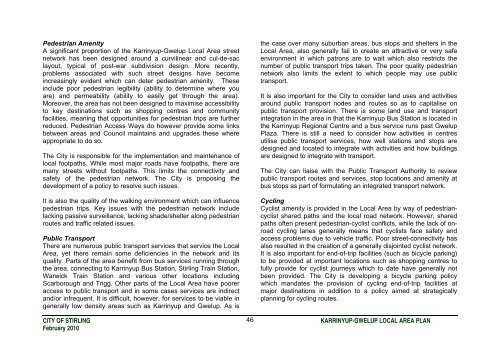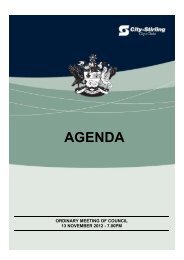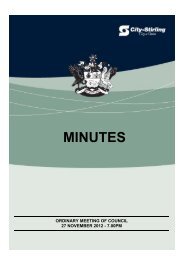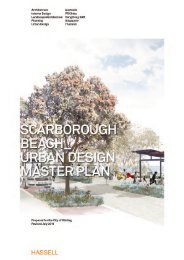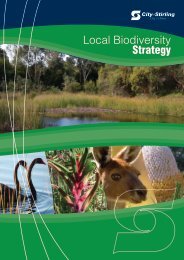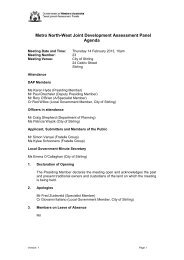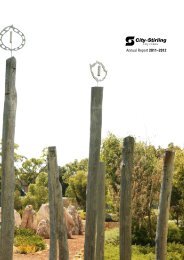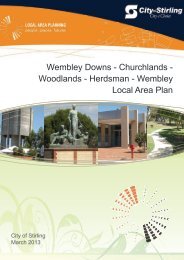KARRINYUP / GWELUP Local Area Plan - City of Stirling
KARRINYUP / GWELUP Local Area Plan - City of Stirling
KARRINYUP / GWELUP Local Area Plan - City of Stirling
Create successful ePaper yourself
Turn your PDF publications into a flip-book with our unique Google optimized e-Paper software.
Pedestrian Amenity<br />
A significant proportion <strong>of</strong> the Karrinyup-Gwelup <strong>Local</strong> <strong>Area</strong> street<br />
network has been designed around a curvilinear and cul-de-sac<br />
layout, typical <strong>of</strong> post-war subdivision design. More recently,<br />
problems associated with such street designs have become<br />
increasingly evident which can deter pedestrian amenity. These<br />
include poor pedestrian legibility (ability to determine where you<br />
are) and permeability (ability to easily get through the area).<br />
Moreover, the area has not been designed to maximise accessibility<br />
to key destinations such as shopping centres and community<br />
facilities, meaning that opportunities for pedestrian trips are further<br />
reduced. Pedestrian Access Ways do however provide some links<br />
between areas and Council maintains and upgrades these where<br />
appropriate to do so.<br />
The <strong>City</strong> is responsible for the implementation and maintenance <strong>of</strong><br />
local footpaths. While most major roads have footpaths, there are<br />
many streets without footpaths. This limits the connectivity and<br />
safety <strong>of</strong> the pedestrian network. The <strong>City</strong> is proposing the<br />
development <strong>of</strong> a policy to resolve such issues.<br />
It is also the quality <strong>of</strong> the walking environment which can influence<br />
pedestrian trips. Key issues with the pedestrian network include<br />
lacking passive surveillance, lacking shade/shelter along pedestrian<br />
routes and traffic related issues.<br />
Public Transport<br />
There are numerous public transport services that service the <strong>Local</strong><br />
<strong>Area</strong>, yet there remain some deficiencies in the network and its<br />
quality. Parts <strong>of</strong> the area benefit from bus services running through<br />
the area, connecting to Karrinyup Bus Station, <strong>Stirling</strong> Train Station,<br />
Warwick Train Station and various other locations including<br />
Scarborough and Trigg. Other parts <strong>of</strong> the <strong>Local</strong> <strong>Area</strong> have poorer<br />
access to public transport and in some cases services are indirect<br />
and/or infrequent. It is difficult, however, for services to be viable in<br />
generally low density areas such as Karrinyup and Gwelup. As is<br />
the case over many suburban areas, bus stops and shelters in the<br />
<strong>Local</strong> <strong>Area</strong>, also generally fail to create an attractive or very safe<br />
environment in which patrons are to wait which also restricts the<br />
number <strong>of</strong> public transport trips taken. The poor quality pedestrian<br />
network also limits the extent to which people may use public<br />
transport.<br />
It is also important for the <strong>City</strong> to consider land uses and activities<br />
around public transport nodes and routes so as to capitalise on<br />
public transport provision. There is some land use and transport<br />
integration in the area in that the Karrinyup Bus Station is located in<br />
the Karrinyup Regional Centre and a bus service runs past Gwelup<br />
Plaza. There is still a need to consider how activities in centres<br />
utilise public transport services, how well stations and stops are<br />
designed and located to integrate with activities and how buildings<br />
are designed to integrate with transport.<br />
The <strong>City</strong> can liaise with the Public Transport Authority to review<br />
public transport routes and services, stop locations and amenity at<br />
bus stops as part <strong>of</strong> formulating an integrated transport network.<br />
Cycling<br />
Cyclist amenity is provided in the <strong>Local</strong> <strong>Area</strong> by way <strong>of</strong> pedestriancyclist<br />
shared paths and the local road network. However, shared<br />
paths <strong>of</strong>ten present pedestrian-cyclist conflicts, while the lack <strong>of</strong> onroad<br />
cycling lanes generally means that cyclists face safety and<br />
access problems due to vehicle traffic. Poor street-connectivity has<br />
also resulted in the creation <strong>of</strong> a generally disjointed cyclist network.<br />
It is also important for end-<strong>of</strong>-trip facilities (such as bicycle parking)<br />
to be provided at important locations such as shopping centres to<br />
fully provide for cyclist journeys which to date have generally not<br />
been provided. The <strong>City</strong> is developing a bicycle parking policy<br />
which mandates the provision <strong>of</strong> cycling end-<strong>of</strong>-trip facilities at<br />
major destinations in addition to a policy aimed at strategically<br />
planning for cycling routes.<br />
CITY OF STIRLING 46<br />
<strong>KARRINYUP</strong>-<strong>GWELUP</strong> LOCAL AREA PLAN<br />
February 2010


